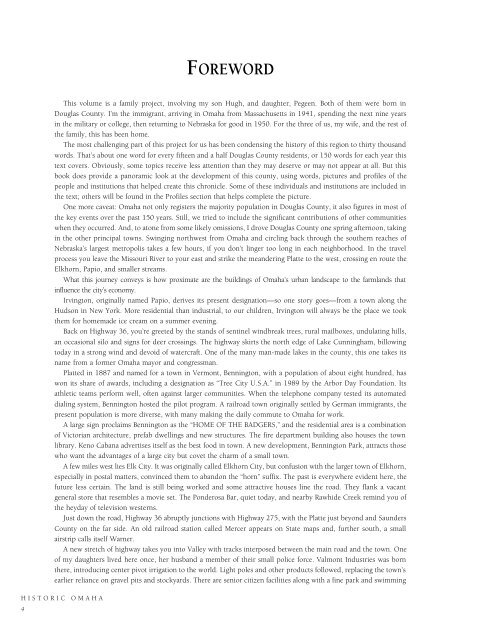Historic Omaha
An illustrated history of Omaha and the Douglas County area, paired with the histories of companies, families and organizations that make the region great.
An illustrated history of Omaha and the Douglas County area, paired with the histories of companies, families and organizations that make the region great.
Create successful ePaper yourself
Turn your PDF publications into a flip-book with our unique Google optimized e-Paper software.
FOREWORD<br />
HISTORIC OMAHA<br />
4<br />
This volume is a family project, involving my son Hugh, and daughter, Pegeen. Both of them were born in<br />
Douglas County. I’m the immigrant, arriving in <strong>Omaha</strong> from Massachusetts in 1941, spending the next nine years<br />
in the military or college, then returning to Nebraska for good in 1950. For the three of us, my wife, and the rest of<br />
the family, this has been home.<br />
The most challenging part of this project for us has been condensing the history of this region to thirty thousand<br />
words. That’s about one word for every fifteen and a half Douglas County residents, or 150 words for each year this<br />
text covers. Obviously, some topics receive less attention than they may deserve or may not appear at all. But this<br />
book does provide a panoramic look at the development of this county, using words, pictures and profiles of the<br />
people and institutions that helped create this chronicle. Some of these individuals and institutions are included in<br />
the text; others will be found in the Profiles section that helps complete the picture.<br />
One more caveat: <strong>Omaha</strong> not only registers the majority population in Douglas County, it also figures in most of<br />
the key events over the past 150 years. Still, we tried to include the significant contributions of other communities<br />
when they occurred. And, to atone from some likely omissions, I drove Douglas County one spring afternoon, taking<br />
in the other principal towns. Swinging northwest from <strong>Omaha</strong> and circling back through the southern reaches of<br />
Nebraska’s largest metropolis takes a few hours, if you don’t linger too long in each neighborhood. In the travel<br />
process you leave the Missouri River to your east and strike the meandering Platte to the west, crossing en route the<br />
Elkhorn, Papio, and smaller streams.<br />
What this journey conveys is how proximate are the buildings of <strong>Omaha</strong>’s urban landscape to the farmlands that<br />
influence the city’s economy.<br />
Irvington, originally named Papio, derives its present designation—so one story goes—from a town along the<br />
Hudson in New York. More residential than industrial, to our children, Irvington will always be the place we took<br />
them for homemade ice cream on a summer evening.<br />
Back on Highway 36, you’re greeted by the stands of sentinel windbreak trees, rural mailboxes, undulating hills,<br />
an occasional silo and signs for deer crossings. The highway skirts the north edge of Lake Cunningham, billowing<br />
today in a strong wind and devoid of watercraft. One of the many man-made lakes in the county, this one takes its<br />
name from a former <strong>Omaha</strong> mayor and congressman.<br />
Platted in 1887 and named for a town in Vermont, Bennington, with a population of about eight hundred, has<br />
won its share of awards, including a designation as “Tree City U.S.A.” in 1989 by the Arbor Day Foundation. Its<br />
athletic teams perform well, often against larger communities. When the telephone company tested its automated<br />
dialing system, Bennington hosted the pilot program. A railroad town originally settled by German immigrants, the<br />
present population is more diverse, with many making the daily commute to <strong>Omaha</strong> for work.<br />
A large sign proclaims Bennington as the “HOME OF THE BADGERS,” and the residential area is a combination<br />
of Victorian architecture, prefab dwellings and new structures. The fire department building also houses the town<br />
library. Keno Cabana advertises itself as the best food in town. A new development, Bennington Park, attracts those<br />
who want the advantages of a large city but covet the charm of a small town.<br />
A few miles west lies Elk City. It was originally called Elkhorn City, but confusion with the larger town of Elkhorn,<br />
especially in postal matters, convinced them to abandon the “horn” suffix. The past is everywhere evident here, the<br />
future less certain. The land is still being worked and some attractive houses line the road. They flank a vacant<br />
general store that resembles a movie set. The Ponderosa Bar, quiet today, and nearby Rawhide Creek remind you of<br />
the heyday of television westerns.<br />
Just down the road, Highway 36 abruptly junctions with Highway 275, with the Platte just beyond and Saunders<br />
County on the far side. An old railroad station called Mercer appears on State maps and, further south, a small<br />
airstrip calls itself Warner.<br />
A new stretch of highway takes you into Valley with tracks interposed between the main road and the town. One<br />
of my daughters lived here once, her husband a member of their small police force. Valmont Industries was born<br />
there, introducing center pivot irrigation to the world. Light poles and other products followed, replacing the town’s<br />
earlier reliance on gravel pits and stockyards. There are senior citizen facilities along with a fine park and swimming
















